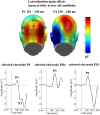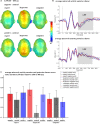Emotion in Context: How Sender Predictability and Identity Affect Processing of Words as Imminent Personality Feedback
- PMID: 30774611
- PMCID: PMC6367230
- DOI: 10.3389/fpsyg.2019.00094
Emotion in Context: How Sender Predictability and Identity Affect Processing of Words as Imminent Personality Feedback
Abstract
Recent findings suggest that communicative context affects the timing and magnitude of emotion effects in word processing. In particular, social attributions seem to be one important source of plasticity for the processing of affectively charged language. Here, we investigate the timing and magnitude of ERP responses toward positive, neutral, and negative trait adjectives during the anticipation of putative socio-evaluative feedback from different senders (human and computer) varying in predictability. In the first experiment, during word presentation participants could not anticipate whether a human or a randomly acting computer sender was about to give feedback. Here, a main effect of emotion was observed only on the late positive potential (LPP), showing larger amplitudes for positive compared to neutral adjectives. In the second study the same stimuli and set-up were used, but a block-wise presentation was realized, resulting in fixed and fully predictable sender identity. Feedback was supposedly given by an expert (psychotherapist), a layperson (unknown human), and again by a randomly acting computer. Main effects of emotion started with an increased P1 for negative adjectives, followed by effects at the N1 and early posterior negativity (EPN), showing both largest amplitudes for positive words, as well as for the LPP, where positive and negative words elicited larger amplitudes than neutral words. An interaction revealed that emotional LPP modulations occurred only for a human sender. Finally, regardless of content, anticipating human feedback led to larger P1 and P3 components, being highest for the putative expert. These findings demonstrate the malleability of emotional language processing by social contexts. When clear predictions can be made, our brains rapidly differentiate between emotional and neutral information, as well as between different senders. Attributed human presence affects emotional language processing already during feedback anticipation, in line with a selective gating of attentional resources via anticipatory social significance attributions. By contrast, emotion effects occur much later, when crucial social context information is still missing. These findings demonstrate the context-dependence of emotion effects in word processing and are particularly relevant since virtual communication with unknown senders, whose identity is inferred rather than perceived, has become reality for millions of people.
Keywords: EEG/ERP; anticipation; emotion; language; prediction; social context; virtual communication.
Figures







Similar articles
-
It's all in your head - how anticipating evaluation affects the processing of emotional trait adjectives.Front Psychol. 2014 Nov 11;5:1292. doi: 10.3389/fpsyg.2014.01292. eCollection 2014. Front Psychol. 2014. PMID: 25426095 Free PMC article.
-
People matter: Perceived sender identity modulates cerebral processing of socio-emotional language feedback.Neuroimage. 2016 Jul 1;134:160-169. doi: 10.1016/j.neuroimage.2016.03.052. Epub 2016 Mar 30. Neuroimage. 2016. PMID: 27039140
-
Perceived communicative context and emotional content amplify visual word processing in the fusiform gyrus.J Neurosci. 2015 Apr 15;35(15):6010-9. doi: 10.1523/JNEUROSCI.3346-14.2015. J Neurosci. 2015. PMID: 25878274 Free PMC article.
-
An Integrated Review of Emoticons in Computer-Mediated Communication.Front Psychol. 2017 Jan 6;7:2061. doi: 10.3389/fpsyg.2016.02061. eCollection 2016. Front Psychol. 2017. PMID: 28111564 Free PMC article. Review.
-
Predicting Affective Information - An Evaluation of Repetition Suppression Effects.Front Psychol. 2016 Sep 9;7:1365. doi: 10.3389/fpsyg.2016.01365. eCollection 2016. Front Psychol. 2016. PMID: 27667980 Free PMC article. Review.
Cited by
-
The influence of lexical word properties on selective attention to emotional words: Support for the attentional tuning of valent word forms.Psychophysiology. 2025 Jan;62(1):e14748. doi: 10.1111/psyp.14748. Psychophysiology. 2025. PMID: 39704114 Free PMC article.
-
Emotional Evaluations from Partners and Opponents Differentially Influence the Perception of Ambiguous Faces.Behav Sci (Basel). 2024 Dec 5;14(12):1168. doi: 10.3390/bs14121168. Behav Sci (Basel). 2024. PMID: 39767309 Free PMC article.
-
How positive and negative feedback following real interactions changes subsequent sender ratings.Sci Rep. 2025 Mar 3;15(1):7470. doi: 10.1038/s41598-025-91750-1. Sci Rep. 2025. PMID: 40032962 Free PMC article.
-
Attending to Eliza: rapid brain responses reflect competence attribution in virtual social feedback processing.Soc Cogn Affect Neurosci. 2019 Oct 1;14(10):1073-1086. doi: 10.1093/scan/nsz075. Soc Cogn Affect Neurosci. 2019. PMID: 31593232 Free PMC article.
-
In a Bilingual Mood: Mood Affects Lexico-Semantic Processing Differently in Native and Non-Native Languages.Brain Sci. 2022 Feb 26;12(3):316. doi: 10.3390/brainsci12030316. Brain Sci. 2022. PMID: 35326272 Free PMC article.
References
LinkOut - more resources
Full Text Sources

